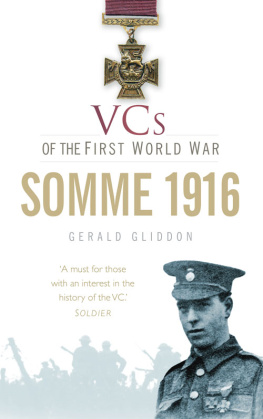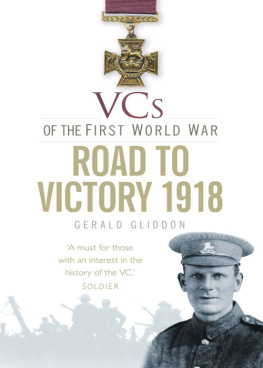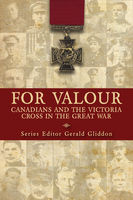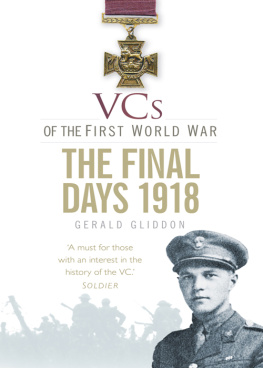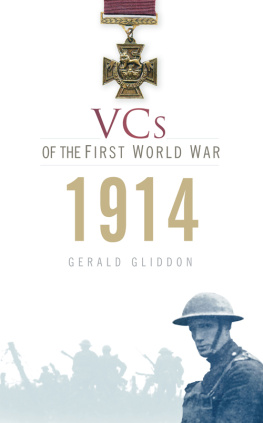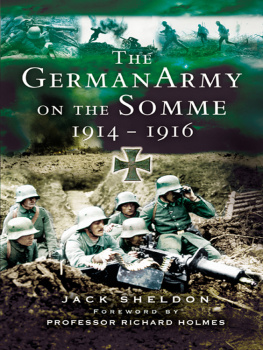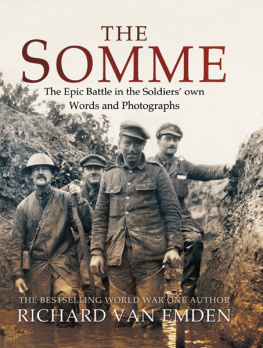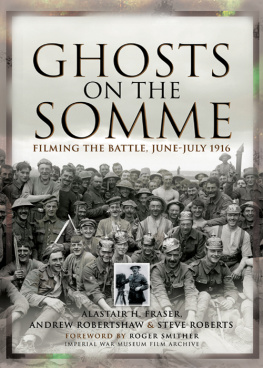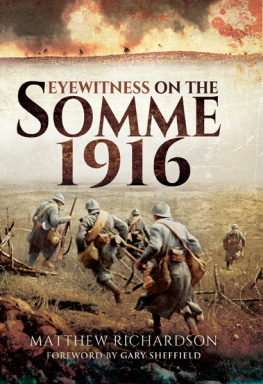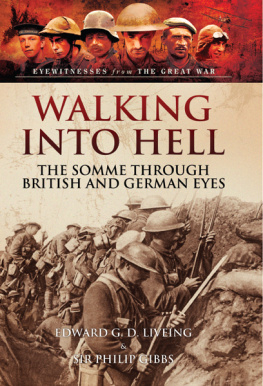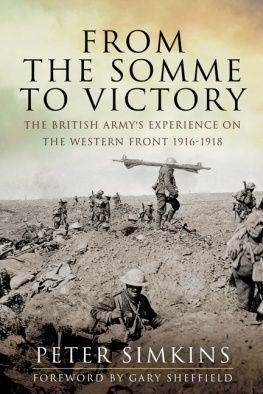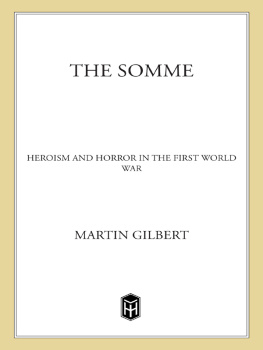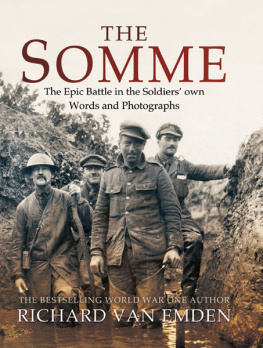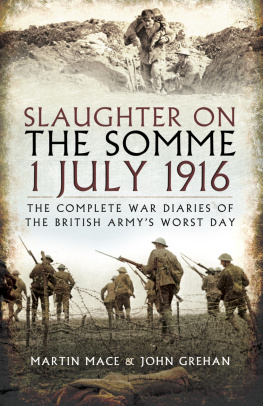
I would like to thank the following institutions and individuals for their very kind co-operation and assistance during the preparation of this book: Australian National Memorial Canberra, Commonwealth War Graves Commission, Gallahers, Imperial War Museum, National Archives of Canada, National Army Museum, Public Record Office, now The National Archives, and the Western Front Association. Peter Batchelor, the late Lady Joan Carton de Wiart, Richard Denyer, Denis Pillinger, Steve Snelling, the late Tony Spagnoly, Martin Staunton, Iain Stewart, Ian Uys and Lieutenant Colonel R.J. Wyatt. My wife Winifred has, as always, been of great support.
C ONTENTS
This book grew out of my earlier book on the Battle of the Somme called When the Barrage Lifts in which all fifty-one Somme VCs make a brief appearance.
I decided to explore the lives of this group of men who won for themselves the highest award for gallantry that their country could bestow. I wanted to try and find out what sort of men they were, and also if they survived the war, what sort of lives that they led after it was over.
The first place to start was with the Canon Lummis collection of material on the lives of all VC holders, which is held at the National Army Museum under the stewardship of the Military Historical Society. Although these files are by no means complete, they do point researchers in the right direction. I wrote to all the regiments associated with the men and to all the local newspapers in their home towns. I contacted the Imperial War Museum, Commonwealth War Graves Commission and Public Record Office (now National Archives, Kew) in addition to the appropriate agencies in Canada, Australia, New Zealand and South Africa. I also, of course, read all that I could get hold of about the lives of these men that had been already published and contacted the families where possible.
I have only set out to write a biographical portrait of each man and not a full blown life story and the average entry is roughly 1,250 words. I have tried to expand on all previous biographical accounts and in most cases I have written more than has been published before. However a number of the men have had whole books devoted to them, i.e. Second Lieutenant D.S. Bell, Sergeant W.E. Boulter, Lieutenant Colonel R.B. Bradford, Captain N.G. Chavasse, Lieutenant Colonel Carton de Wiart, Major W. La T. Congreve, Lieutenant Colonel B.C. Freyberg and Private T.A. Jones. Each section begins with the appropriate action in 1916 when the deed for which the Victoria Cross was awarded took place, and then the story reverts to the soldiers early life.
I have listed my main sources at the back of the book under bibliography and appendices. The bibliography covers all the men that I have written about and the appendices with sources give some details of where I obtained much of the rest of the information.
I would be very grateful to hear from any reader who may have any suggested corrections to make or who might have additional information.
British troops first began to arrive in the Somme region in July 1915 when they took over from the French Army who had been in the area since 1914. At the beginning of 1916 General J. Joffre, Commander-in-Chief of the French Army and General Sir Douglas Haig agreed that the British and French armies should carry out a joint offensive north of the River Somme at the beginning of July.
After a two-day postponement caused by poor weather, the Battle of the Somme began at 7.30am on 1 July after a massive seven-day Allied bombardment. Fourteen British divisions with two French divisions on their right climbed out of their trenches on an 18 mile front to the north of the River Somme, and slowly advanced on the strongly held German positions. By the end of the day the advance on the British front had failed everywhere except for small gains at the southern end of the battlefield. There had been 57,000 British casualties either killed or wounded on that disastrous first day and by 18 November, when the battle officially ended, nearly a million men from the Allied and German armies had become casualties.
The Victoria Cross was instituted in 1856 and is still made from Russian cannons captured at Sebastopol. The decoration weighs 430 grams and is 1 inches square.
During the Great War no less than 634 awards of the VC were made, of which fifty-one were for the Battle of the Somme. The spread of ranks who won the medal is a fairly wide one, with twenty going to officers, twelve to non-commissioned officers, and nineteen going to privates or their equivalent. In order to qualify for a medal it was of course very important to be seen carrying out the deed itself. No doubt there were many cases when a man deserved a Victoria Cross, yet went unrewarded. However, I have no qualms about the merits of the Somme VC holders, although it is true to say that many of the men did not feel themselves justified in accepting such a high honour when they had seen similar acts of bravery performed around them on the battlefield.
Many of the awards were for the saving of life and not just for rushing forward in the heat of battle with a Lewis gun to an enemy-held trench and spraying it with fire. Indeed many VC winners did both, killing Germans and saving their compatriots lives in equal measure. Surely the most heroic figure was Pte W.F. McFadzean who in smothering some grenades that had spilt their pins truly gave his life for those of his friends. On the other hand it can be argued that no battle could possibly be won if the momentum was to be continually interrupted by the saving of the lives of casualties. As the Somme battle progressed, the job of saving lives was reserved for the stretcher bearers who accompanied the advance or battle.
I am not going to speculate here on the meaning of bravery and where a line can be drawn between heroism and foolhardiness, all I will say is that valour and personal sacrifice are two of the good things that come out of any war.
A third of the Somme VCs were awarded posthumously and only thirty-three men survived the war. If the VC holder survived then very often he received a considerable amount of what was probably unwanted publicity. He was often invited back to his home town by the local council who then presented him with gifts or an Illuminated Address, among other things. Some men were also given a gift of money until the War Office cracked down on the practice. It is difficult not to regard all this local attention as an exercise in exploitation and one that helped to encourage local belief in the war effort and in turn help with industrial output in the form of munitions and other vital war materiel. There are many photographs of men who have won the VC looking downright embarrassed by the whole business.
The winning of the coveted award also brought other problems in that each man was marked out as something special, and if he digressed then it would almost certainly be written up by the press, for example Cunningham and Kelly. Others too, could never settle down after the war, although the award of the VC could not be given as the reason but rather the effect of the war itself. Captain W.B. Allens health was permanently destroyed and he had to resort to alcohol and opium, Private T. Hughes took to the bottle, Private M. OMeara never regained his sanity, Private J. Cunningham beat up his wife and Lieutenant Sergeant F. McNess committed suicide.
On the other hand, several men seemed almost to qualify for the award of the decoration as if by right, men such as Lieutenant Colonel A. Carton de Wiart, Major W. La T. Congreve, Lieutenant Colonel R.B. Bradford and Lieutenant Colonel B.C. Freyberg, who were all brilliant and courageous soldiers. It would surely only be a matter of time before they qualified for the highest of military honours? Others had no problems with the award and took its ownership in their stride. I am thinking here of men like Second Lieutenant T.E. Adlam, Captain A.C.T. White, Private R.E. Ryder and Private T.A. Jones. Todger Jones, who rounded up 102 Germans single handed, even had correspondence with a film company based in Wardour Street about plans to make a film out of the heroes of the Somme. He wasnt expecting to co-operate without payment either!
Next page
